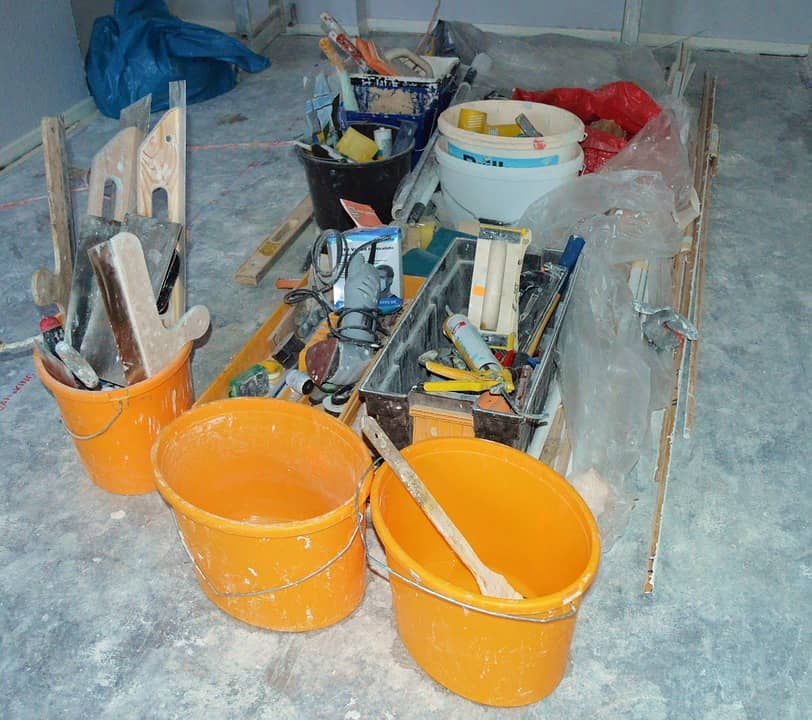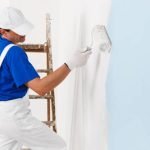10 Tips to Paint a Room without Making a Mess

Some people just assume that painting is a messy job. It can be, but it certainly doesn’t have to become a nightmare of a project. A little planning and preparation can go a long way in helping cut down on the mess that is created by interior painting. You can save a lot on professional labor by doing the work yourself, but you could risk creating twice the mess along the way. Fortunately, there’s a way to create balance. Keep reading to get the best tips for mess-free painting and valuable insight on how to create a professional-looking finish, even when you’re doing the work yourself.
Paint Jobs Are 80% Preparation
One of the reasons that some people loathe painting is because there is so much setup and prep work, and very little actual painting, that takes place. Painting a single room could take an hour or two if it weren’t for all the furniture moving, trim taping, floor covering, and other prep work that has to come before you crack the paint can and start rolling on the fresh coat.
That’s why the majority of the tips to help reduce the mess when painting are all about prep work. There are a few helpful tips for application and cleanup, but, honestly, the way that you set the project up can make all the difference in whether or not you’re working cleanly and efficiently. Without further ado, here are the biggest tips for mess-free painting in every room of your home.
Move and/or Cover Furniture
If you have furniture along the walls of the room, move it out of the way. If you have the space to move the furniture entirely out of the room, that will obviously be the best choice. The fewer things in your way, the better. Cramped spaces lead to big messes because you don’t have the space that you need to work efficiently and safely.
If you have to leave furniture in the room you are painting, cover it with a drop cloth or plastic and tape around the seams so that none of the furniture surfaces are exposed. Stack everything in the middle of the room as far from the walls as possible so that you have room to get to all of the trim, baseboards, and ceilings, as well.
Spills and splatters are inevitable, so it’s better to cover everything just to be safe.
Protect Your Floors
Some people incorrectly assume that hard surface flooring doesn’t need protection from paint. After all, once it dries, it should scrape right up, shouldn’t it? It should, but it doesn’t always. Plus, a splatter here or a drip there is one thing, but what if you have an accident and dump an entire tray or gallon of paint on the floor? That could take forever to clean up, and it might not all come out.
Cover your Floors before painting
Carpets
When painting, cover your carpet with canvas drop cloths for the best results. You can use plastic, old linens or tablecloths, or even cardboard, but canvas offers the best protection for carpet because it won’t rip and provides a durable cover that you can walk on and work on without worry.
Hard Floors
Rosin paper (craft paper) or plastic sheeting is fine for hard surfaces – tiles, laminate or hardwood flooring, but make sure that you cover ALL flooring to prevent big messes or major damage.
Remove as Many Wall Fixtures as Possible
You should take down all switch plates, outlet covers, and other wall covers that will get in the way. The covers can be removed and set aside (make sure you tape the screws to the cover or leave them in the screw holes), and then you can use painters’ tape to cover the switch or outlet itself. Then, you’ll be able to paint easily around outlets and switches and when you replace the covers, the finish will be perfect.
Some people try to get away with just taping the covers themselves, but you aren’t going to be able to get as close to the edges to get the best results. Plus, you could risk making a mess of the covers and having to clean them afterward.
Protect Doors and Windows from Splatter
Paint rollers often cause a mist that leaves specks of paint below the roller, which can get onto windows, door trim, handles and locks, and other areas that you don’t want painted. Tape around all the door and window trim with painter’s tape and use plastic to cover door openings and window panes so that the paint is contained. Otherwise, you might find yourself scraping windows and repainting doors unnecessarily.
If it’s not getting painted, cover it. That way, you don’t have to worry about drips, splatter, spray, or any other paint accidents along the way.
Wipe Down ALL Surfaces Before Starting
Of course, you are going to wash the walls prior to painting, but did you even think about dusting and wiping down the trim and other surfaces in the room? People tend to overlook these areas, but it’s crucial to a mess-free painting job. Painter’s tape is designed for easy removal.
Therefore, it’s not going to be super-sticky and won’t stick well to surfaces that are dusty or have debris buildup (think baseboards and window sills). Take the time to wipe down the entire room so that everything is clean and dry. Then your paint and your tape will stick better, giving you better results and a better chance of mess-free painting.
Use a Putty Knife for Taping Assistance
To avoid painting carpets and to help with taping in tricky corners or with intricate trim, use a putty knife. For carpets, use a two-inch piece of painter’s tape, and run it along the length of the baseboard with about half an inch of the tape left up on the baseboard.
Then, take the putty knife and push the tape down below the baseboard, in between the carpet and the trim, for the perfect seal every time. A putty knife is a great tool for taping because it can get into places your fingers might not be able to reach. Take advantage of that.
Save Face by Applying Lotion Prior to Painting
If you want to avoid making a mess of yourself, there’s a handy trick that everyone can use: apply a generous coating of body lotion to exposed areas of your skin (hands, arms, face, etc.) before you start painting. Then, the splatters and drips that get on your skin will rinse of easily because of the oily barrier created by the lotion. Plus, your skin will get a nice little moisturizer, so it’s win-win.
Use Acne Pads to Remove Paint Drips
No matter how hard you try to be neat, you’ll likely get paint on at least one thing that shouldn’t have paint on it. Acne pads, which are primarily an alcohol mixture, are great to use for quick paint removal. They shouldn’t bleed or fade furniture or upholstery, and they will take out most paints with just a few dabs. Just remember to squeeze out any excess liquid before using the pad so that you don’t smear the paint and create a bigger mess.
You can find a lot of home remedies and products you already have on hand that can help clean up paint messes. If you don’t want to use harsh chemicals to clean up, this might be the way to go.
Take Advantage of Painting Tools
So many people will get set up to paint without even considering all of the tools available to assist them. They will go buy rollers, brushes, and paint trays, and call it a day. There are edgers, foam brushes, detail tools, and so many other specialty painting brushes on the market today that there’s no reason for you to waste time or make a mess by limiting yourself to standard brushes and paint rollers.
Sure, you might spend a little more on premium tools, but imagine the peace of mind from your clean, hassle-free paint job. It’s definitely worth the investment.
Plus, if you take advantage of these tools, you might find yourself spending less time taping because you can be more careful. That could save hours on preparation because painting and covering things is one of the most time-consuming steps in the painting process.
Hang and Bag Light Fixtures
Rather than trying to tape off a flush-mounted fixture and get close when painting a ceiling, you can actually remove the fixtures for an easier time. Just take off any glass bulbs, covers, and other parts first and set them in another room for safe keeping. Then, unscrew the fixture from the ceiling and use a wire to hook the fixture to the junction box (such as an old metal hanger or other wire). Slip a bag over the fixture, and you’re good to go.
Conclusiuon
Painting can be messy, but it doesn’t have to be. With these tips, you’ll find yourself spending less time cleaning up and more time enjoying your handiwork. Plus, now that you know how to paint with less mess, you’ll never stress about painting your home in the future.
 (877) 663-5483
(877) 663-5483 (844) 333-1387
(844) 333-1387



